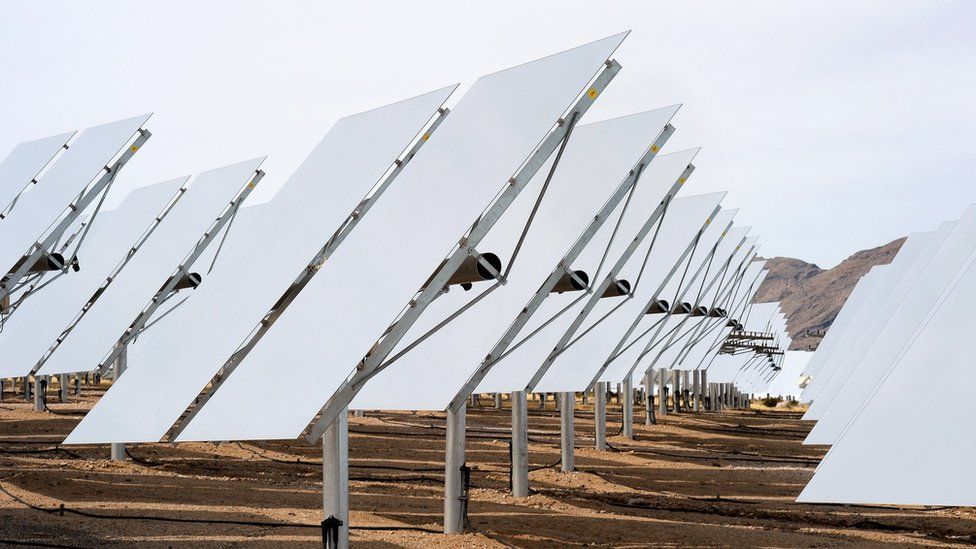Why are Californian solar firms paying to give away power?
- Published

California companies are generating so much solar power that firms in other states are getting paid to take it.
The state has been forced into the arrangement to "avoid overloading its own power lines", according to the Los Angeles Times.
The situation doesn't necessarily mean we are "throwing money away", says economist Severin Borenstein, a professor at UC Berkeley's Haas School of Business.
"But it probably is an indication that there are some serious problems in the way we're running the grid and the way we're making investment decisions."
Why is this happening?
Electricity production from renewable sources has skyrocketed in California.
And that doesn't include the thousands of individual solar panels installed in recent years.
The growth is thanks in part to laws that require half of the electricity sold to consumers to come from renewable energy sources by 2030.
Meanwhile, production from traditional energy sources hasn't stopped.
About 60% of electricity generated in California came from natural gas in 2015.
Supply increased about 7% from 2010, after regulators - in part responding to a series of blackouts and energy problems in the early 2000s - approved more power plants.
The LA Times says California has a "glut of power".
But demand for energy is shrinking.
Between 2010-15, residential energy consumption per capita in the US dipped.
Some experts say energy efficient light bulbs are one reason why.
California, where it tends to be warm and sunny, also has among the lowest per capita electricity consumption of any state in the country.
So supply and demand are getting out of whack - especially at peak sunshine hours.
That is a problem. In extreme cases, production spikes can overwhelm power lines and end in power outages.
One response from grid operators has been to cut production from solar and wind producers, which they say are responsible for excess supply.
In 2016, about 1.6% of solar electricity generation was curtailed, according to the California Independent System Operator, which runs the state's electric grid and wholesale electricity market.
But what was that about getting paid to take electricity?
Renewable energy is sold using long-term contracts - and in real time on a regional wholesale market, where prices fluctuate based on supply and demand.
The price heads below zero on the wholesale market when there's too much supply. In those instances of "negative pricing" companies pay other firms to take their power.
Why would they do that?
In some cases, a utility or other company has already paid for the power at a higher price but doesn't need it.
In other cases, it is more expensive for the solar power company to stop production than it is to pay a firm in another state to take the electricity because of how their tax benefits are structured.
The examples of negative pricing are rare but increasing. They occurred in more than 5% of five-minute market intervals in 2016, up from about 4% the year before, according to CAISO.
Is this happening anywhere else?
Yes. The growth of renewable energy has led to negative pricing in Texas, which has a lot of wind power, in the UK and other parts of Europe, including Germany.
Are California families getting lower electricity bills because of this?
Not really.
California households pay some of the highest electricity rates in the nation. Those reflect higher prices negotiated in the long term renewable contracts as well as fees assessed to pay for new gas and solar plants.
What's more, if utilities have to pay other firms to take their power, it cuts into profits - a cost that eventually gets passed on to ratepayers, says Professor Borenstein of the Haas School of Business.
How about families in those other states?
Customers of utilities that get paid to take the power may be benefiting, according to the LA Times. And big companies with more flexible electricity packages may also be able to take advantage of the situation, says economist James Bushnell, a professor at UC Davis.
What are the proposals to fix this?
One option is to change the way tax subsidies for renewable energy work, so that firms don't have as much incentive to keep their plants running at full capacity when the power isn't needed.
Another option would be to make the retail market more flexible. Then families could opt to charge phones, electric cars and the like when electricity is cheapest.
"Economists for a really long time have said let's make retail rates reflect wholesale prices," says Lucas Davis, a professor at the Haas School of Business at UC Berkeley. "Now I think is a great time for economists to renew that push."
What's the bigger picture?
Energy consumption is changing and the growth of renewable energy, especially solar, has left the market in turmoil. Some hope investments will lead to technology that stores energy more effectively. But in the meantime negative prices are one sign of the ways the market is changing.
"All these things started when there were very small amounts of renewables," says Mr Bushnell of UC Davis. "The idea that we would have such a massive quantity that we would want to dump it, wasn't really thought through."